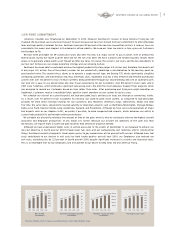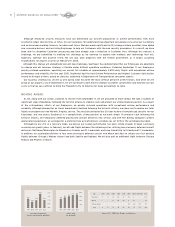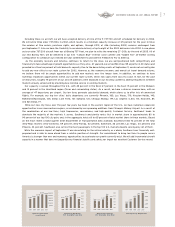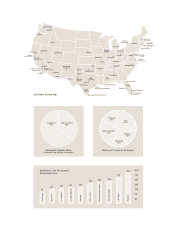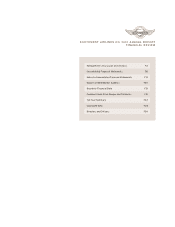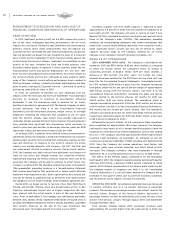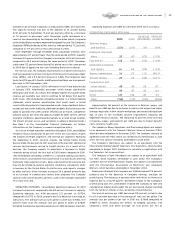Southwest Airlines 2001 Annual Report Download - page 15
Download and view the complete annual report
Please find page 15 of the 2001 Southwest Airlines annual report below. You can navigate through the pages in the report by either clicking on the pages listed below, or by using the keyword search tool below to find specific information within the annual report.
and derivative instruments used to hedge its exposure to jet fuel price
increases. The Company also operates 99 aircraft under operating and
capital leases. However, leases are not considered market sensitive
financial instruments and, therefore, are not included in the interest
rate sensitivity analysis below. Commitments related to leases are
disclosed in Note 8 to the Consolidated Financial Statements. The
Company does not purchase or hold any derivative financial instruments
for trading purposes. See Note 2 to the Consolidated Financial
Statements for information on the Company’s accounting for its hedging
program and Note 9 to the Consolidated Financial Statements for further
details on the Company’s financial derivative instruments.
The fair values of outstanding financial derivative instruments related
to the Company’s jet fuel market price risk at December 31, 2001, were
a net liability of approximately $19.4 million, which is classified in
accrued liabilities in the Consolidated Balance Sheet. The fair values of
the derivative instruments, depending on the type of instrument, were
determined by the use of present value methods or standard option
value models with assumptions about commodity prices based on
those observed in underlying markets. An immediate ten percent
increase or decrease in underlying fuel-related commodity prices from
the December 31, 2001, prices would correspondingly change the fair
value of the commodity derivative instruments in place by approximately
$55 million. Changes in the related commodity derivative instrument
cash flows may change by more or less than this amount based upon
further fluctuations in futures prices as well as related income tax
effects. This sensitivity analysis uses industry standard valuation
models and holds all inputs constant at December 31, 2001, levels,
except underlying futures prices.
Airline operators are inherently capital intensive as the vast majority
of the Company’s assets are expensive aircraft, which are long-lived.
The Company’s strategy is to capitalize conservatively and grow
capacity steadily and profitably. While the Company uses financial
leverage, it has maintained a strong balance sheet and an “A” credit
rating on its senior unsecured fixed-rate debt with Standard & Poor’s
and Fitch ratings agencies, and a “Baa1” credit rating with Moody’s rating
agency. The Company’s Aircraft Secured Notes and French Credit
Agreements do not give rise to significant fair value risk but do give
rise to interest rate risk because these borrowings are floating-rate
debt. Although there is interest rate risk associated with these secured
borrowings, the risk is somewhat mitigated by the fact that the
Company may prepay this debt on any of the semi-annual principal and
interest payment dates. See Note 7 to the Consolidated Financial
Statements for more information on these borrowings.
As disclosed in Note 7 to the Consolidated Financial Statements, the
Company had outstanding senior unsecured notes totaling $400 million
at December 31, 2001. Also, as disclosed in Note 7, the Company issued
$614.3 million in long-term debt in November 2001 in the form of
Pass-T hrough Certificates (Certificates), which are secured by aircraft
the Company owns. The total of the Company’s long-term unsecured
notes represented only 6.2 percent of total noncurrent assets at
December 31, 2001. The unsecured long-term debt currently has a
weighted-average maturity of 9.0 years at fixed rates averaging
7.6 percent at December 31, 2001, which is comparable to average
rates prevailing over the last ten years. The Certificates bear interest
at a combined weighted-average rate of 5.5 percent. The Company
does not have significant exposure to changing interest rates on its
unsecured long-term debt or its Certificates because the interest rates
are fixed and the financial leverage is modest.
The Company also has some risk associated with changing interest
rates due to the short-term nature of its invested cash, which was
$2.28 billion at December 31, 2001. The Company invests available
cash in certificates of deposit and investment grade commercial paper
that generally have maturities of three months or less; therefore, the
returns earned on these investments parallel closely with floating
interest rates. The Company has not undertaken any additional actions
to cover interest rate market risk and is not a party to any other material
interest rate market risk management activities.
A hypothetical ten percent change in market interest rates as of
December 31, 2001, would not have a material effect on the fair value
of the Company’s fixed rate debt instruments. See Note 9 to the
Consolidated Financial Statements for further information on the fair
value of the Company’s financial instruments. A change in market
interest rates could, however, have a corresponding effect on the
Company’s earnings and cash flows associated with its Aircraft
Secured Notes, French Credit Agreements, and invested cash because
of the floating-rate nature of these items. Assuming floating market
rates in effect as of December 31, 2001, were held constant throughout
a 12-month period, a hypothetical ten percent change in those rates
would correspondingly change the Company’s net earnings and cash
flows associated with these items by approximately $2.1 million.
However, a ten percent change in market rates would not impact the
Company’s earnings or cash flow associated with the Company’s
publicly traded fixed-rate debt, or its Certificates.
SOUTHWEST AIRLINES CO. 2001 ANNUAL REPORT F7


